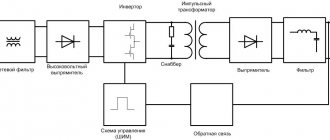Hand generator
As it turns out, our hands are a good source of energy.
Researchers at the Georgia Institute of Technology have designed a generator that is activated by touch.
The compact size of the generator allows you to easily insert it into your phone and use the energy obtained from touching your fingers on the display to charge the device.
The generated energy is generated by the frictional force between two polymer layers. This energy will be enough to fully charge the phone.
Powerful manual charging at 30-40 watts
A monster among hand chargers. Why is she attractive? This is power. According to the manufacturer, it is very powerful and is capable of delivering up to 30 watts of electrical energy. Igor Beletsky presented a review, and, according to his admission, he cannot even imagine how you can squeeze 30 watts out of such a small box measuring only 10 x 6 centimeters. Yes, it just fits in your hand. However, looking ahead, let's say that he managed to squeeze even 40 watts out of it.
There are many similar single-handle chargers sold on the Internet. But their power, as a rule, does not exceed 10 watts. It comes with a very serious set of wires. As they say, for all occasions. Well, for example, the most basic wire with a built-in voltage stabilizer. Pay attention to the positions from 3 volts to 28 volts. Using the switch, you can smoothly set any position and charge your devices. According to the test with a multimeter, everything is clear, even 0.5 volts are left. Anything you need! It was bought from this Chinese store. Name: 30W 0-28V Hand Dynamo Hand Emergency Generator with DC Converter.
Powerful manual charging
The wire branches into 4 more, where there is USB, where you connect your phones, tablets, Power banks. Anything that requires 5 volts to charge. Another mini USB and two plugs. One fits under the laptop, the second goes to the wire, which ends with two alligator clips. This is apparently so that the batteries can be charged. There is also a wire that is attached to the charger and also ends with two crocodiles. They have stickers - red (plus) and black (minus). This is a rarity that you don’t see everywhere these days.
Products for inventors Link to the store.
Pay attention to how the wire is connected to the charger. First, each has a metal plug. It can only enter in one single position. There is a special groove, by aligning which you can insert the charger into the plug. The nut is screwed on and clamps the plug. The wire itself goes into the plug and is additionally clamped at the input with small bolts.
The charger itself is made in a metal style. It is assembled from 2 metal halves, with a rubber gasket between them, which means that it is waterproof. The device is held in the hand by a leash, which is tightened and holds the hand tightly. A slight inconvenience is that you won’t be able to completely wrap your fingers around the device, as they will interfere with the rotation of the handle. But you get used to it easily. The ergonomics are rectangular, all edges are rounded, so, in principle, it is quite comfortable to hold.
DIY electronics in a Chinese store.
Checking charging power
For accurate measurements we will use an electronic wattmeter and variable resistance. Let's start with the phone. We connect it and set the stabilizer to 5 Volts. We start rotating and the phone instantly “lights up” and depicts charging. Let's switch to a wattmeter with resistance. Let's see how many watts we squeeze out. We charge at the same pace and observe the wattmeter reading. Voltage 5 Volts, power 5 Watts. Enough to charge any phone. Current 1 ampere. This is an excellent result.
We connect the tablet. The stabilizer has the same 5 Volts. Let's start rotating. 65%. It says: charging from the network. Which indicates that the current exceeds 0.5 Ampere. Which is exactly what we need. A tablet will require from 5 to 10 watts. Let's see how much effort it will take to produce such power. Here they are, the desired 10 watts. How long can you turn the handle at this pace? This is quite easy to do. Supposedly, for a well-trained person, it is possible to rotate the handle for half an hour. The author of the video, in his opinion, will last 10 minutes.
For a laptop, there is no question of proper nutrition, only recharging. In reality, this device is suitable for all gadgets. The author is most interested in whether he can squeeze the claimed 30 watts out of the device. Therefore, we now move on to the most important experiment.
Crash test for squeezing maximum power from the charger
Peak power reached 40 watts! The resistance became heated in a matter of seconds. It was impossible to pick it up. This suggests that this device is capable of delivering not only 30, but also 4o watts. It all depends on whether there is an appropriate physical effort at the input. Even without great physical strength, the author of the review managed to show this. For people who go hiking and are more physically developed, this device is a godsend. They can use it to charge their phone, tablet, or recharge their laptop. In case of complete isolation from civilization, this is a very necessary thing. The author of the reviews is pleasantly surprised that the manufacturer did not deceive and honestly wrote the declared power. It turned out that you can even surpass it. The quality is appropriate. Perhaps it was copied from a military model or was made with an eye to military orders. It has no competitor in its weight and size characteristics.
It's interesting to see what's inside the black box. There is a transmission gear mechanism here. What is he like? Plastic gears or metal? It is very important. The most interesting thing is, what kind of generator is here? Cheaper models have conventional commutator motors. For example, those that are on printers. Considering the power, it must be of impressive size. And here it’s only 4 centimeters. It just won't fit here. Therefore, presumably there is some kind of tricky generator here. Perhaps even on neodymium magnets. A separate video with an overview of charging in analysis. All details will be shown.
Mechanism and principle of operation of a manual charger
To understand how a hand charger works, we need to think about its larger cousins, wind turbines.
The wind turns the propeller, which in turn turns the turbine. If we simplify the description of this physical process, then it will be enough to say that the propeller blades receive kinetic energy from the wind, which can also be called motion energy. The blades are forced to rotate around their axis by the screw rod to which they are attached. Rotation of the rod produces rotational energy, which is transferred to the generator. In the case of a wind turbine, the generator is a set of magnets rotating around a twisted cable. The magnets rotating around the cable create the electric current that can be used to power equipment.
There are many types of handheld cell phone chargers, but they are similar in design to wind turbines, only greatly scaled down. The main element is a handle that a person rotates. This handle plays the same role as a wind turbine propeller.
The person turns the handle and thereby imparts rotation to the rod. The kinetic energy generated by the power of the human hand is transferred to this rod. This energy is transferred to the charger generator, which produces an electric current with a voltage of 4 to 6 volts, which allows you to slightly recharge a dead mobile phone battery. Using this device is as easy as shelling pears: grab the handle and rotate it.
Number of revolutions
For generators, there are graphs or tables that relate the output current to the rotor speed. Some models reach rated power at much lower rpm than others. The lower the engine speed at full generator output, the more suitable it is for charging batteries at idle.
Standard engine pulleys and heavy-duty generator pulleys sometimes prevent them from delivering full power within the desired rpm range. This is due to the fact that the pulleys are designed for car engines operating at 2500 - 3500 rpm, and when charging batteries at idle, the engine speed is 700 - 1000 rpm. Since engines and their operating modes on boats and yachts differ, the size of the generator pulley must be selected individually using the following procedure:
- Determine what engine speed should correspond to the maximum generator power
- Find the maximum allowable rpm of the generator (usually 10,000 rpm).
- Determine the minimum engine speed for normal use (or the engine speed for charging batteries and running the refrigerator if the engine is most often used for these purposes when parked)
- Select the alternator pulley to achieve the maximum power required at the selected minimum engine speed. Check that the generator does not exceed the permissible rotation speed at maximum engine speed. If the generator rotor exceeds the permissible rotation speed, change the gear ratio so that the maximum generator speed is achieved at maximum engine speed.
Example:
The yacht is equipped with a generator with a rated current of 130 amperes. Maximum power required 100 amps (77% of rated power). The generator produces 100 amps at 3000 rpm. The maximum safe operating speed is 10,000 rpm. The boat spends most of its time at anchor. When parked, the engine idles at 1000 rpm to charge the batteries.
In order for the generator rotor to rotate at 3,000 rpm at engine idle speed, the gear ratio of the pulleys must be 3: 1. The maximum engine speed is also 3,000 rpm. At these speeds, the generator speed will be 9000 rpm, which is within safe operating limits.
How to check the operation of the generator
The battery in a car is an important element of the system, which is responsible for providing the car’s on-board network with electricity. The generator is used to charge the battery while it is active. Unstable operation of a device generating electricity causes a voltage drop in the network and failure to restore the capacity of the power source.
Normal generator performance means timely and complete replenishment of the battery charge level, which decreases under load. Checking the battery charge level from the generator is simple and can be done by the car owner himself.
Diagnostics of an automotive energy-generating device includes a visual inspection of the unit, its elements and related parts, as well as voltage and current measurements. At least twice a year, you should check the tension of the drive belt, excessive weakening of which leads to a decrease in the performance of the generator, and sometimes can lead to breakdown of the device. Once a year, you can check equipment elements - fasteners, diode bridge, voltage regulator and others. Timely maintenance of the battery will also guarantee the absence of problems - cleaning the terminals, adding distilled water.
Diagnostics of indicators such as voltage, current, resistance are also necessary twice a year. To carry it out, you will need special devices - a voltmeter, multimeter or load fork.
Wind turbine
Photo: Nanjing Hongyu New Energy Technology Co.,Ltd / AliExpress
But something cooler is a real wind turbine that produces up to 400 W. In the city, however, you are unlikely to carry it with you, but it is quite possible to take it on a long tourist trip to install it in a camp or even at a dacha.
Buy
And if you don’t want to spend money on Chinese inventions, make a turbine yourself from plastic bottles, as in the video below.
The author has compiled detailed instructions here.
How many amperes does a car alternator produce per battery?
The current strength required by the electrical system of each car is individual and depends on the number of electricity consumers and their values. And also the charge current must be sufficient to charge the power source.
It is worth noting that ampere readings appear only when there is a load in the vehicle’s electrical system and, accordingly, the battery is discharged. After starting the car engine, the charging current is about 6-10 amperes and drops over time, because the battery is charging, taking on the main energy consumption. If you turn on additional equipment - headlights, radio or heated mirrors, you can see an increase in the charging current values.
When purchasing a generator, pay attention to its technical characteristics, which the manufacturer indicates on the case - that’s where you will find information about the maximum current that will flow to the battery.
In the table below you can see the approximate current values that the generator shows at different loads.
Table 1. How many amperes the generator produces under load.











